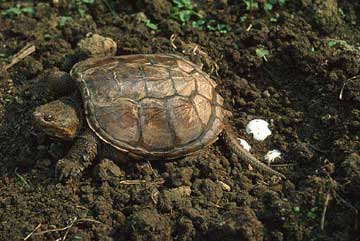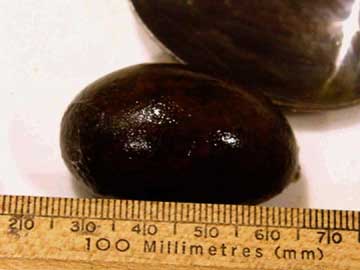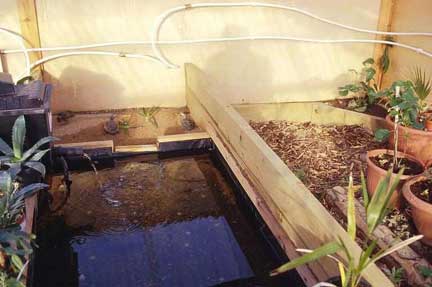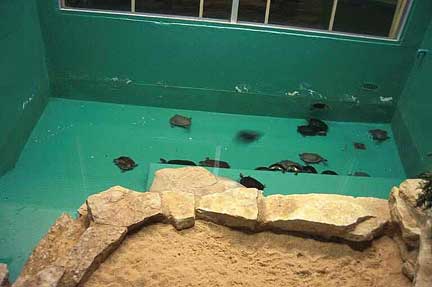
![]() How to Create Naturalistic Nesting Sites for Egg-laying
Turtles
How to Create Naturalistic Nesting Sites for Egg-laying
Turtles
The prevention of dystocia (egg-binding) by environmental management
Nadine Gill

Snapping Turtle (Chelydra serpentina) nesting
There is a serious misconception amongst many keepers of aquatic turtles that if one does not wish to incubate the eggs of a gravid female, or if the eggs are not fertile, the turtle can be left to simply lay her eggs in the water rather than provide her with an appropriate nesting site. Indeed, if given no option, such turtles may often lay their eggs directly in the water, but they will also tend to retain them longer than if a nesting site had been made available.
As witnessed by the author, and reported by keepers of both Red eared sliders and Painted turtles to the Tortoise Trust, a gravid female without a nesting site will lay eggs one or two at a time over a period of weeks rather than lay the entire clutch simultaneously, or may indeed choose to retain all the eggs rather to deposit them in the water at all. This is an unacceptable situation for the turtle, and indeed places her at considerable risk of serious illness and even death.
Retained eggs become increasingly calcified the longer they are held. The eggshell, which is normally flexible in many (but not all) aquatic turtles, will become brittle and may fracture internally; causing egg-yolk peritonitis, a very serious condition that can quickly prove fatal if not treated in the earliest stages.

A severely degraded, retained egg
In some cases, a turtle not given a nesting area will lay most of her eggs, giving the impression that all has gone well, but unknown to the keeper, she may have retained the rest. The two discolored eggs pictured were from a Red eared slider kept in a large aquarium without a nesting area that had to be induced with oxytocin in order to lay her remaining eggs. One of these eggs was already fractured and the female required a course of antibiotic injections to treat a resulting infection.
It is often possible to induce a reluctant turtle to lay her eggs with oxytocin (usually preceded by a few days of injectable calcium gluconate), as was the case with this fortunate turtle. However, when this fails or is not an appropriate option because the natural passage of the eggs is not possible, or where a delay in treatment results in further complications, surgery may be needed to remove them. This is a major operation that normally requires entry to coelemic cavity through the plastron, and an extended period for healing.
Though egg retention can be caused by other health factors, such as metabolic bone disease, a malformed, oversized or fractured egg, oviductal rupture, infection, or any mass impinging on or obstructing the oviduct, a common cause (that can easily be avoided) is the lack of a proper nesting area. By simply offering a gravid aquatic turtle a suitable nesting site you will greatly reduce the dangers of dystocia and egg-yolk peritonitis. Fortunately, these sites may be quite simple, but do keep in mind that the final decision of suitability lies entirely with the turtle! This can prove quite frustrating to the well-intentioned keeper when different nesting area designs are each rejected in turn by their quite gravid, yet discriminating female.
In the wild, a gravid turtle is very particular about the site she chooses, so it is of vital importance that turtles maintained in captivity are provided with as near a natural nesting experience as can be achieved. Turtles may choose to not lay if they find the nesting conditions unsuitable. The best way to determine the requirements is to research the natural history of the species of turtle you keep, and to certainly take advantage of any opportunity to observe it in the wild.
Gravid females ready to lay their eggs will emerge from the water in search of a nesting site, the nature of which will vary between species. Individual turtles of the same species may have their own individual preferences as well. For example, Sternotherus oderatus often make shallow nests, and have been known to lay their more brittle eggs under leaf litter, logs, rotting wood, or inside the walls of a muskrat lodge. However, some of these common musk turtles prefer to nest on open ground, while others have been reported to dig nests to a depth of 10 cm (Ernst, C. H., Barbour, R. W. 1989). As you can see, it is very helpful to be aware of the different types of nests that have been reported for the species you keep when considering the options to include in a nesting area.
Turtles will also have preferences in the time of day they nest, often choosing to lay in the evening or early morning hours, so it may help to keep the turtle’s basking light on later into the evening than usual. The light warms the nesting area and tends to encourage the turtles to enter into a trace-like state in which they dig a nest more readily. Though disruptions can interfere with their progress before this point, and should therefore be avoided, once females enter into this nesting mode, they often appear to be undisturbed and even unaware of the presence of someone observing. There does not yet appear to be a complete understanding of this response, but observations suggest that the basking light at night may not only warm the substrate, but that the light shining on the nesting area in an otherwise darkened room may also provide the nesting turtle with greater focus, by reducing distractions.
In the wild, a gravid female will likely inspect different sites before selecting the one where she will ultimately lay her eggs. Female T. scripta will typically seek out a well-drained, open area, but if they encounter a rock or other barrier that prevents them from excavating to the proper depth they will abandon that spot and try another. One female observed dug six different holes in a 15m length of trail before being satisfied with one and laying her eggs (Cagle, 1937). Captive conditions rarely provide this large an area, so the space we have to work with needs to be designed well. Make the nesting area as large as possible, and with adequate depth, so the turtle will not hit the bottom when digging.

An aquatic turtle installation with nesting area at the Tortoise Trust, UK
Turtles also have preferences in substrate, so choose one that best approximates the type that would be present in the natural habitat of the species. For example, the natural substrate of Red eared sliders, Painted turtles and European pond turtles could be approximated by combining a 50/50 mixture of sand and organic compost, whereas a softshell turtle would prefer a nesting substrate with a greater percentage of soft sand. A musk turtle would likely appreciate some leaf litter scattered on the substrate, and (given the space) possibly a piece of log that the female might choose to deposit her eggs under.
In general, when preparing the nesting substrate, remove any stones, root or branch material that may be found in the compost mixture so as to make the finished substrate soft, and thereby easier for the turtle to dig a nest of adequate depth in. Some species, including T. scripta and C. picta, will soften dry hardened soil by releasing some fluid from the cloacal bladders, but will abandon a site if they encounter any obstruction when digging. Obstructions can deter other species as well, so by removing any stones or branches from the substrate, providing adequate depth, and occasionally misting the substrate to keep it from hardening, you will make the nesting area more inviting to common aquatic species, including T. scripta, C. picta, and E. obicularis.
Rainfall may trigger nesting behavior in turtles. Studies indicate that nesting activity in snapping turtles has increased with light rain (Hammer 1969), and that C. picta may retain eggs during hot weather and drought (Ernst, pers. obs.). T. scripta generally prefers a well-drained nesting site, and in temperate climates will usually nest between April and July. However, in tropical areas the species may nest in the dry season when the soil is less likely to be saturated with water (Ernst, C. H., Barbour, R. W. 1989). Applying this to captive conditions, by keeping the nesting substrate well-drained (but soft), and just slightly moistened by periodic misting, we would avoid the extremes of water saturated or hardened soil and likely make the area more desirable to a gravid female.
Temperature is an important factor in nesting for all turtles and warming ambient temperature has been found to trigger nesting behavior in snapping turtles (Obbard and Brooks 1987) and other species. It is therefore always advisable to maintain the approximate water and ambient air temperature that coincides with the nesting response of your particular species in the wild.
You may not notice any visual evidence when your turtle has nested, so check the substrate for eggs on a regular basis. If you do plan on artificially incubating the eggs, you will need to have an incubator ready. You will also want to research your species to determine the optimal conditions for incubation of its eggs in advance.
Once you determine what a species of turtle requires in a nesting site, and the environmental conditions that prompt it to nest, you can then begin to design an appropriate area in the captive habitat. The options are many and the ultimate design will be enhanced or limited by your personal knowledge of the species, and the aquatic accommodation you are working with.

A sandy substrate is appropriate for many species
Preformed ponds are particularly suited for the addition of a land and/or nesting area. Some come with shelves already provided, upon which an area can be created. You can permanently wall off a section (and waterproof with silicon aquarium sealer), which is quite attractive, but an easy and quick way is to make a nesting box is to use a large plastic storage container with sides deep enough so that the water level of the shelf area will be below the top of the container. You can then fill the container with a mixture of 50% organic compost and 50% play sand or packaged sand (sold as desert substrate) that you can purchase in pet stores, allowing for modifications depending on the species. The nesting areashould be, at a very minimum, twice the width and length of the turtle. Wider and longer is certainly better if the space is available. Ehrenfeld (1979) calculated the depth of the nest for a given turtle by the length of the fully extended hind legs, after the tilting of the shell was taken into account, but in general practice, a substrate depth of ¾ the length of the carapace should be adequate.
Once the filled container is placed on the shelf of the pond, place rocks around the side that the turtle can easily climb up to reach it, or provide a ramp with cork bark or some other suitable material. A basking light should be placed over this area.
A walled off area would be a permanent feature, that could include some plants, grass and a nesting site, but a simple nesting box can be temporarily placed in the pond during nesting season (or whenever the turtle displays nesting behavior), and then removed once the turtle has laid her eggs. These can be preferable in smaller habitats. In either case, some substrate will be carried back into the water by the turtle, which should not cause a problem to filtration, and can be siphoned out during a routine water change, if desired.
A nesting box can also be made in an aquarium, but you will have to securely place it on a shelf (to prevent movement) to keep the upper edge of the box above water. You may find something that you can use as a suitable shelf in the houseware section of your local department or hardware store. One possibility could be the shelving used in modular closets. Measure the needed height before you go, and choose a container and shelf that together bring the upper edge an inch or so above the water line. Avoid creating any areas underneath the waterline where a turtle swimming may become trapped within and drown.
Though tortoises will sometimes lay successfully when placed into an external nesting box, this is not a desirable option for aquatic turtles. The stress of being removed from accustomed surroundings, without the opportunity to retreat or have access to water is not conducive to nesting. Constant access to water is particularly critical for the more soft-skinned, highly aquatic species, such as musk turtles, which are known to more quickly suffer from the effects of dehydration (Ernst 1968b). Therefore, it is strongly recommended that any aquatic accommodation for females provide for the inclusion of a nesting area.
In addition to creating a suitable nesting site, you will also need to be able to recognize nesting behavior, as well as any signs that could indicate that your female is suffering from dystocia.
IDENTIFYING NESTING BEHAVIOR
You will notice a change in your turtle’s behavior when she is gravid and almost ready to lay her eggs. She may appear more active, even frantic, and be clawing at the sides of her tank as if she wanted to get out. You may also see her making digging motions with her back legs. The developing eggs will begin to occupy a greater portion of the abdominal area as the time grows near, so the turtle may not eat as much as she normally would. At the first sign of nesting behavior (and preferably before), the nesting area should be made ready.
ABNORMAL BEHAVIOR
If a gravid turtle is unable to lay her eggs naturally despite a keeper’s best efforts to provide a suitable nesting area, medical intervention may be necessary. The reason for dystocia may be environmental, but can also be physical in nature, so if the following symptoms appear, do not delay. A veterinary evaluation and ex-ray are necessary to begin appropriate treatment and avoid further complications. Although chelonians usually respond well to oxytocin, the treatment is most effective when initiated within 48 hours of dystocia being diagnosed, and when preceded by calcium treatment as discussed above. If your turtle has difficulty swimming, cannot remain level in the water, or appears to be unable to walk or move her back legs normally, she may be unable to lay her eggs. A turtle displaying these symptoms should be brought to a qualified reptile vet without delay to determine her condition.
Eggs may be felt by gently palpating the region of the body cavity above the hind legs, but not always. (Note: palpating must be done with extreme caution as it can fracture an egg). An x-ray, however, will normally confirm their presence, as well as the number, density, and condition of any eggs. If appropriate, egg laying may be artificially induced. A calcium injection followed by the hormone oxytocin is given, and the turtle will normally lay her eggs within one to four hours. The turtle should be placed directly into her nesting box after the medication is given.
If the turtle expels any foul smelling fluid, it may indicate that an egg has fractured and egg-yolk peritonitis is present. The turtle should be taken to the vet immediately, and if a fracture is detected, the eggs would need to be removed, the area flushed clean of any remaining material, and a course of antibiotic injections prescribed to treat/prevent infection. Handle the turtle very gently and try to avoid any jostling and unnecessary stress when bringing them to the vet.
Dystocia is amongst the greatest health threats to a female turtle, so whether or not your turtles eggs are fertile, or even if you have no intentions of incubating the eggs if they are – by providing your aquatic turtle with an area that allows for natural nesting behavior, you will be make this time much less stressful for her, and prevent the possibility of serious health problems that can quite easily be avoided.
References:
Cagle, F. R. 1937. Egg laying habits of the slider turtle
(Pseudemys troostii), the painted turtle (Chrysemys picta), and the musk turtle
(Sternotherus oderatus). J.
Hammer, D. A. 1969. Parameters of a marsh snapping turtle
population,
Obbard, M. E. and Brooks, R. J. 1987. Prediction of the onset of the annual nesting season of the common snapping turtle, Chelydra serpentina. Herpetologica 43:324-328
Ernst, C. A., Lovich, J. E., Barbour, R. W. 1994. Turtles of
the
Ernst, C. H., Barbour, R. W. 1989. Turtles of the World.
Kuchling, G. 1998. The Reproductive Biology of the Chelonia.
Ehrenfeld D. W. 1979. Behavior associated with nesting.
Harless M., Morlock H. (eds) Turtles perspectives and research. John Wiley.
Ernst C. H. 1968b. Evaporative water-loss relationships of turtles. J. Herpetol. 2:159-161.
(c) 2002-3 Nadine Gill / Tortoise Trust